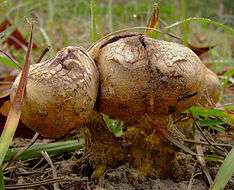Scleroderma meridionale
Scleroderma meridionale is a puffball-like fungus in the family Sclerodermataceae. It was originally described in 1970 from Portugal,[1] but is also found in North America. The fungus has a roughly circular to irregularly shaped fruit body up to 6 cm (2.4 in) in diameter with a thick, rooting base. The peridium is up to 2 mm thick and has a dry, roughened surface colored tan to yellow. Mature fruit bodies tend to split into irregular lobes, revealing a dark brownish- to blackish-gray spore mass (gleba). The spores are spherical with small spikes and measure 12–20 µm. Scleroderma meridionale grows in sandy areas, where it fruits singly or scattered in a partially buried state. Its edibility is unknown.[2]
| Scleroderma meridionale | |
|---|---|
 | |
| Scientific classification | |
| Kingdom: | |
| Division: | |
| Class: | |
| Order: | |
| Family: | |
| Genus: | Scleroderma |
| Species: | S. meridionale |
| Binomial name | |
| Scleroderma meridionale Demoulin & Malençon (1971) | |
See also
References
- Demoulin V; Malençon G. (1970). "Un nouveau Scléroderma méditerranéo-sud-atlantique: Scleroderma meridionale Demoulin & Malençon, spec. nov". Bulletin de la Société Mycologique de France (in French). 86 (3): 699–704.
- Bessette AR; Bessette A; Neill WJ. (2001). Mushrooms of Cape Cod and the National Seashore. Syracuse University Press. p. 101. ISBN 978-0-8156-0687-1.
This article is issued from Wikipedia. The text is licensed under Creative Commons - Attribution - Sharealike. Additional terms may apply for the media files.